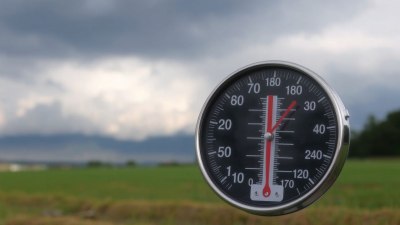Why Holding Hands in the Cold Is the Original Climate Control
Explore the significance of holding hands in cold weather and its impact on warmth and connection.

In today's fast-paced world, where climate change is a pressing issue and the environment is constantly shifting, one of the simplest gestures can be considered as the original form of climate control: holding hands in the cold. This practice not only provides physical warmth but also fosters emotional bonds, creating a unique positive feedback loop between physical temperature regulation and emotional connectivity. In this article, we will delve into the science behind temperature regulation through physical touch, the historical context of holding hands, and the broader implications of such simple gestures on human relationships and climate awareness.
The Science Behind Warmth and Touch
When it comes to human interaction, physical touch plays a significant role in our ability to feel warmth, both emotionally and physically. Studies have shown that the human body responds to physical closeness in a variety of ways. The act of holding hands triggers a series of physiological responses that enhance psychological comfort. When two people hold hands, they share body heat, which can lead to a rise in temperature. This is particularly important in cold weather, where the ambient temperature can drop to levels that are uncomfortable or even dangerous.
According to research published by scientists at the University of California, Berkeley, physical touch not only helps to reduce stress but also increases the production of oxytocin, often referred to as the 'love hormone.' Oxytocin is associated with bonding, trust, and social connections, leading to feelings of warmth and comfort. In colder climates, holding hands becomes a survival mechanism, as the shared warmth can reduce the risks of hypothermia and frostbite, further solidifying the importance of this act as a natural form of climate control.
A Historical Perspective on Holding Hands
Throughout history, holding hands has transcended cultural boundaries, representing unity, companionship, and protection. In many societies, it is an essential gesture of affection and support. For example, in ancient cultures, holding hands was often associated with vows and promises, signifying a bond that was not easily broken. This practice can be traced back to primitive societies where humans relied on each other for survival, especially in harsh, cold environments.
In the 19th century, Victorian culture placed a strong emphasis on the importance of romantic gestures, with holding hands being a precursor to courtship. Young couples would often walk together hand-in-hand, navigating societal norms while embracing the warmth that connection brings. As time has progressed, the symbolism of holding hands has evolved, but its essence remains the same—it's a universal expression of solidarity and love, important in both cold and warm climates.
The Role of Holding Hands in Modern Times
In a rapidly changing world where climate change has become a pressing issue, the gesture of holding hands takes on new dimensions. The simple act can be seen as a metaphor for collective action against global warming and environmental degradation. As people grasp hands, they not only create warmth but also foster a sense of community in facing the challenges of climate change together. This act embodies the idea that humans must unite to combat the environmental threats that affect us all.
Holding hands serves as a reminder of our interconnectedness—not just with those close to us, but also with the planet itself. As temperatures rise and weather conditions become increasingly erratic, the importance of physical closeness becomes even more pronounced. It highlights the need for teamwork and cooperation in addressing climate-related issues. Indeed, as the world faces a climate crisis, the message conveyed through holding hands can inspire collective actions for environmental preservation.
Emotional Benefits of Holding Hands
In addition to its physical benefits, holding hands has profound emotional impacts. It has been linked to reducing feelings of anxiety and depression, enhancing mood, and promoting emotional stability. The comfort derived from holding hands can significantly mitigate the effects of stressful situations, whether they arise from the outside world or personal turmoil.
Modern psychological studies reveal that physical touch, including hand-holding, can trigger the release of stress-reducing neurotransmitters like dopamine and serotonin. This effect can be particularly beneficial in cold weather, where individuals may feel isolated or vulnerable. By holding hands, people not only experience warmth but also a sense of safety and reassurance. This emotional support is vital for building resilience in the face of both personal struggles and broader societal issues such as climate change.
Creative Ways to Promote Holding Hands
To encourage this simple yet powerful action, individuals and communities can explore creative initiatives. For instance, organizing hand-holding events in public spaces during cold months can promote unity while raising awareness about climate issues. These events can serve as an opportunity for participants to connect not only with one another but also with the environment. Community leaders can advocate for campaigns that highlight the importance of personal connections, encouraging people to take a moment to hold hands and reflect on their relationship with the Earth.
Moreover, educational programs can integrate the concept of holding hands as a form of emotional and physical resilience against climate challenges. Lessons on human warmth, community bonding, and climate action could empower individuals to recognize their capacity for both warmth and activism, reminding them that even small acts matter.
Cultural Expressions Around the World
Globally, cultures have embraced hand-holding in various forms. For instance, in Asian cultures, holding hands is a common expression of friendship, regardless of gender. In many Middle Eastern countries, hand-holding between men is also a sign of camaraderie, showcasing how physical touch transcends societal norms. In Western cultures, romantic couples holding hands during strolls is a symbol of connectedness and intimacy. Each cultural context adds layers of meaning to the simple act of holding hands, demonstrating its significance across the globe.
Hosting multicultural events celebrating hand-holding traditions can further enhance community ties and engage people of diverse backgrounds in discussing climate change. Sharing stories and experiences about how their cultures express intimacy and solidarity empowers groups, creating a sense of belonging that extends beyond mere words.
Conclusion: A Call to Action
As we navigate through uncertainties, it is essential to remember the power of physical touch and what it can signify both personally and collectively. Holding hands in the cold transcends the mere act of connecting two individuals; it shapes our understanding of community, environment, and emotional well-being. This simple gesture can serve as a reminder that, amidst adversity, we can generate warmth and support not just for ourselves but for those around us, fostering solidarity in battling climate change.
So, the next time you find yourself in a chilly environment, consider reaching out to hold a loved one's hand—not only for warmth but also as a symbolic act of unity in our shared responsibility to protect the planet. Embrace this original form of climate control as a way to strengthen bonds and inspire collective climate action.











